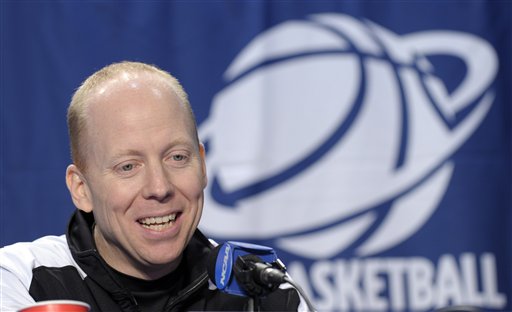Cincinnati’s Mick Cronin Sees Positive Side in New-Look Big East
Posted by Chris Johnson on September 27th, 2012Chris Johnson is an RTC Columnist. He can be reached @ChrisDJohnsonn.
There has been no shortage of discussion surrounding the impending basketball decline in the Big East. By now, you’ve surely heard that by 2015, the loaded league we all came to know and love will have lost a sizeable chunk of its upper-echelon talent. I’m talking about Pittsburgh, Syracuse, West Virginia and Notre Dame – four valuable hoops entities who, as is the case with most realignment movement, are chasing more lucrative football-fueled media rights packages (Notre Dame, whose TV contract with NBC is college sports’ most unbreakable bond of broadcast loyalty, is the lone exception). But the Big East itself, the league, the brand, the unit, isn’t going anywhere. Sure, it has settled on some bizarre geographic additions, but Temple and Memphis are valuable upgrades – elite programs that, from a purely basketball-centric perspective, pretty much any league would welcome with open arms. Combined with holdovers Georgetown, Villanova, Marquette, Cincinnati, Louisville and St. Johns, that’s a diverse but promising collection of strong programs. Conference realignment may have staggered the Big East, and it’s unlikely the league will ever regain its status as the nation’s best basketball conference, but the new-look membership is more than passable in the context of power conference hoops. I’d argue it’s still one of the top five leagues in the sport, particularly if SMU’s Larry Brown experiment generates the national attention and relevance that program sorely lacked, and if Central Florida can overcome its NCAA penalties.

With so much turnover in the next few years, Cronin believes the Bearcats are on the rise in the restructured Big East (Photo credit: AP Photo).
For the remaining members, those loyal bystanders who abstained from the massive conference realignment wave, the departures of three historic programs leaves a significant power void at the top of the league’s competitive totem pole. Syracuse, Georgetown, West Virginia and Pittsburgh didn’t just deplete the Big East in the obvious, quantifiable way (the league now has four fewer members). It fundamentally altered the conference’s identity. For decades the Big East served up a steady dose of riveting rivalries, legendary coaches and a unique brand of hard-nosed east coast hoops. The realignment reshuffling has skewed that image, but it also presents a silver lining for the programs who chose to stick around. Cincinnati coach Mick Cronin understands the negative perception hovering around the Big East’s realignment defections, but he sees a rather opportune moment for his program. Long overshadowed by the likes of Syracuse and Pittsburgh and West Virginia, along with a handful of other Big East heavyweights, Cronin sees an opportunity to remold the league’s power structure, with the Bearcats claiming a prime position in the conference hierarchy. SNY.TV, a broadcast affiliate of the storied league, spoke with Cronin over the weekend.
“So the changing of the Big East, it just gives us a chance to plant our flag deeper. And for any team, for the rest of us, that when you do win there’s room in the print for the story because there’s just so many other good teams.”
Kudos to Cronin for finding a silver lining amid the onrush of negative criticism being heaped upon the Big East’s new competitive structure. His statement deals mostly with his own program, but it can be applied to the rest of the league all the same. Now that Syracuse and Pittsburgh are moving on, the Big East lacks two of the elite flagship programs that promoted its hoops brand on the national stage. Notre Dame and West Virginia were promising league stalwarts in their own right. But you could almost always count on Jim Boeheim and Jamie Dixon bringing highly competitive outfits to the NCAA Tournament, and making deep runs once there. Their departure opens the door for another program (or three) to rise up and inherit that lofty perch. Cronin believes his team is fully capable, and it’s hard to blame him. Though it lacks the national import of its recently departed foes (even with a long and illustrious tradition), Cincinnati has quietly built itself into one of the Big East’s best programs. Last season was proof enough of that fact. After its inglorious moment in the Crosstown Shootout, perhaps the only time Cincinnati garnered even a sliver of national attention before March, the Bearcats rolled through conference play, sustained their momentum en route to the league tournament final and fought through 11-seed Texas and 3-seed Florida State before falling to eventual Final Four participant Ohio State in the Sweet Sixteen. It was a strong run, and there was nothing fluky about it.
There’s little doubt Cronin has his program on an upward trajectory. But with so many established programs presiding over the Big East’s ruling elite, there was always some measure of doubt over whether or not Cincinnati could ever break into the league’s upper-tier. Thanks to conference realignment, that exclusive club has room for new company, and Cincinnati is poised to join the party.












































